ASSIGNMENT ONE
While working on this project I became acquainted with the creativity of artists such as Jackson Pollock , Jessica Warboys, Shen Wei and I have learnt a lot from them in the field of physical approach to work, and their emotional approach to creative work like their activity during performances, the way they handle random events that arise during creation so as to achieve the desired effect, satisfying our expectations and arousing emotions. Everyone has their own individual approach, and you can get a lot out of them, but whether it should be followed or imitated is the question.
During this project, I have the impression that it has crossed a certain limit. I felt compelled to move away from figurative painting to the abstraction which is a well-known art form, but whether it reflects how I want to create – I do not know. In a word, it is a completely new field of expression and a medium of communication. How I used it – I certainly did not settle certain behaviors in some events, but it is more important to watch in front of the computer monitor because in the home it would be very complicated. But the impression of this kind of strange new impressions with which I can get to work, something always remains, however, from some experiments we never fail to give us this message is very clear.
Speaking of the fact that this project, in a sense, rejects figurative painting in favour of more spectacular impressions because abstract painting forces us to read out of a different dimensions and looks into a different sense in us. In abstract paintings we all see something different. Strangely, my task was to draw conclusions from this kind of creativity and use them to create a series of images. I do not know if the series should have a common theme or if the following images should have some type of relationship with me. I have decided to give them the same subject.
I decided to create a very imaginary series of images with a common undertone.
While working on the exercise with diagrams I created a strange landscape –
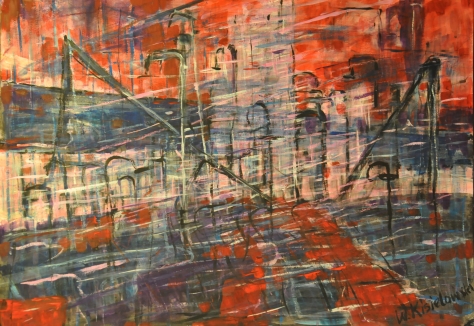
I decided to use this theme and used a variety of experimental techniques to create a series of images. In this work I present a certain creative process and show the skills and experiences I acquired during the exercises, and during the analysis of the works of artists from the group mentioned as recommended, but also artists from outside the circle such as Cecily Brown , Maria Moser.
I tried to compose a coherent relationship between these creations with both of the materials that I am using: the family of paints and colours and the general nature of the work created. The recipient then has a clear reception and understands the series of work that evaluates in a different way.
I tried to make the work, in my opinion, comply with the assessment criteria. I technically and visually demonstrated the right level, made myself the author as a creative artist who does not experiment, and used my imagination in a proper way and I can arouse interest in his work.
I called the whole series of Catharsis Landscape.
Catharsis (from Greek κάθαρσις katharsis meaning “purification” or “cleansing”) is the purification and purgation of emotions—particularly pity and fear—through art[1] or any extreme change in emotion that results in renewal and restoration.
I think this name is very adequate and has a real relationship with my project. I think naming my work this way is a good idea.
In the first series of my creations, the picture shows a very saturated, red landscape in which I spread the sponge root, then using a painting knife I spread the excess paint on paper. I then used a brush and pastels to add aggressive spectacular forms to increase the drama of the work and give it a proper, often random, expression
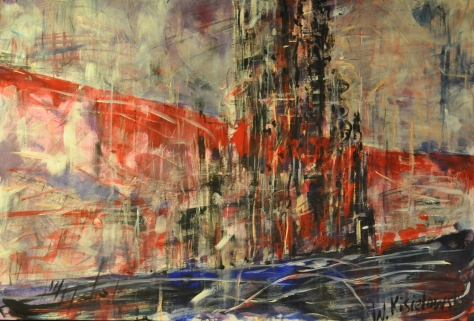
I then decided to change the colour and used the same tools to check how the nature of this work will change in a different shade. I wanted to see if the dramatic effect on the creation will increase or decrease, or if our perception will change through the warmer shades.
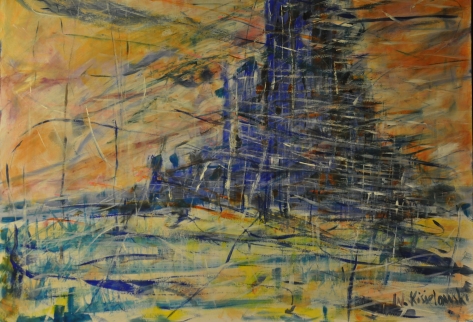
Then I decided to refer to the fourth project and to take the whole process of painting with no brush off. In this work I used a painting knife and an inpasto gel mixed with acrylic. I repeatedly used the previous work as a base, but I tried to make the whole process more painterly and I elaborated the drawing in favour of the brush. Sometimes wiping off spilt paint on the surface created a pretty and interesting structure. I took care of the colour directions and created the atmosphere of vibration. It seems that the colours go in all directions, but I have control over that. Certain directions of these vibrations are stronger and they make my work stronger, because it uses the colour in a more free way. It is difficult to describe but many of these forms were very random and created accidentally in control.
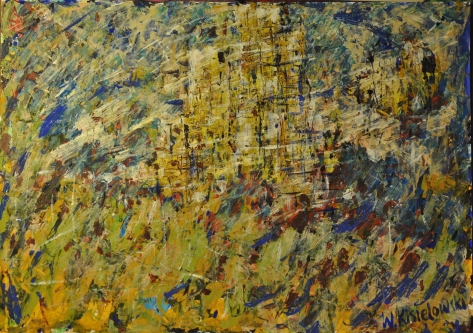
Then I decided to change the format to portrait and concentrate on my imaginary building, referring to the first exercise where we had to draw in a more painterly way, using lines as a connecting element. In a similar manner, I turned a wide flat brush in which I deprived a part of the hair, dipped in paint, and cut the lines in a very controlled delicate way. Background was painted in a similar way as the first and second painting. I think I created an interesting rotating object, but I am not sure about the position in which we should see it, the landscape or portrait. I do not know which one would be more readable.

In the next image, I returned to the exercise with a diagram and decided to paint a king of futuristic map of tubular elements, with geometrical forms that guide us in the soil of the picture, whether it is a grid, construction, or a map. It was my intention of putting a blind trap for the recipient, and to create an image that evokes thought. From a compositional point of view, I think it came out very well. The picture seems to be a more interesting type of grid that divides the picture into parts. Thanks to this we can concentrate on particular parts of the image separately, a large plane of a bold colour could have overwhelmed us. It’s such an industrial pink landscape with distraction in the foreground.
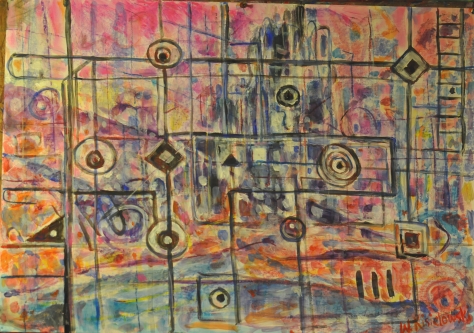
The last of the presented projects is the image referring to exercise 1.3 where I used plastering putty to build the first layer after which I allowed to run very diluted paint, using glassware and after I left my prints in the form of a circle after wetting. I then connected geometrical elements with lines and tried to leave the dissolved paint on the surface, sprinkling it gently with a brush. I think that the geometry forms would be considered as a kind of cartographic element. I took care of it coloristically with a paint covered sponge squeezed to fill empty spaces, retouching only some elements with a brush.
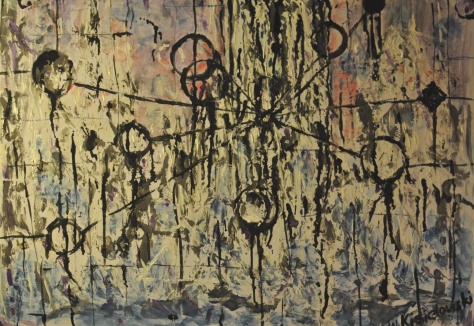
I was very challenged with this whole task due to the fact that I work at home without having the opportunity to fully meet all expectations, but at the same time I would like to make my work so irrelevant that I would be diverted to a completely different dimension in thinking about creating expression, emotion, or physical contact with the art that the latter is certainly lacking in my works, but the most important thing is letting myself be aware of this might be an opportunity to express myself fully.